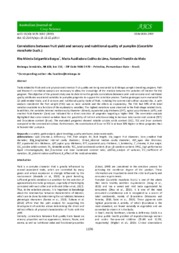Correlations between fruit yield and sensory and nutritional quality of pumpkin (Cucurbita moschata Duch.)
Correlations between fruit yield and sensory and nutritional quality of pumpkin (Cucurbita moschata Duch.)
Autoria: BORGES, R. M. E.; LIMA, M. A. C. de; MELO, N. F. de
Resumo: Traits related to fruit yield and physical and chemical fruit quality are being evaluated by Embrapa pumpkin breeding program. Path and Pearson's correlation analysis are necessary to allow the knowledge of the relation between the variables of interest for this program. The objective of the present study was to determine the genetic correlations between yield- and sensorial and nutritional quality attributes-associated variables in pumpkin progenies to support the selection process. Twelve genotypes were evaluated for 10 yield-related traits, and 8 sensory and nutritional quality traits of fruit, including the commercial cultivar Jacarezinho. A path analysis considered the fruit weight (FrW) was as basic variable and the others as explanatory. The FrW had 98% of its total variation available in a function of the explanatory variables. The highest variations were observed in the fruit-shape related traits. In addition, the variables internal median cavity diameter (IDmed), equatorial pulp thickness (EPT), apical pulp thickness (APT), and smallest fruit diameter (Dsm) are indicated for a direct selection of progenies targeting a higher FrW. The correlation analysis highlighted that color-related variables have the possibility of indirect selection aiming to increase total carotenoid content (TCC) and ?-carotene content (?-car). The evaluated progenies showed notable soluble solids content (SSC), TCC and ?-car contents compared to the commercial cultivar. Furthermore, the contribution of ?-car to TCC is at least 50% higher in these progenies than in 'Jacarezinho' pumpkin.
Ano de publicação: 2019
Tipo de publicação: Artigo de periódico
Unidade: Embrapa Semiárido
Observações
1 - Por padrão são exibidas publicações dos últimos 20 anos. Para encontrar publicações mais antigas, configure o filtro ano de publicação, colocando o ano a partir do qual você deseja encontrar publicações. O filtro está na coluna da esquerda na busca acima.
2 - Para ler algumas publicações da Embrapa (apenas as que estão em formato ePub), é necessário ter, no celular ou computador, um desses softwares gratuitos. Sistemas Android: Google Play Livros; IOS: iBooks; Windows e Linux: software Calibre.
Acesse outras publicações
Acesse a Base de Dados da Pesquisa Agropecuária (BDPA) para consultar o acervo completo das bibliotecas da Embrapa.

